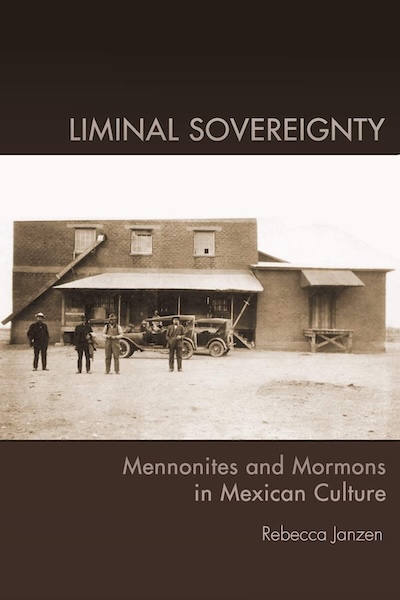Review: Liminal Sovereignty
Benjamin Nobbs-Thiessen
Liminal Sovereignty
By Rebecca Janzen
State University of New York Press, 2018
pp. 220
Reviewed by Benjamin Nobbs-Thiessen

Rebecca Janzen’s new book explores the many “spaces of encounter” in which transplanted Mennonites and Mormons engage with Mexican national identity. Historian Jurgen Buchenau once wrote that Mexican immigration history was valuable as a story of “small numbers, great impact” and Janzen’s study joins a now vibrant literature on non-traditional communities in that nation.1 Like narratives of Chinese and Syrian-Lebanese Mexicans, Janzen shows how these, “groups at the edges are an integral part of the nation.”2
Janzen tackles national belonging through a diverse source base including identity registration cards, land dispute records, television shows, feature films, and photo series. A Latin Americanist by training she pairs this with a robust but accessible discussion of key concepts (racial mixture or mestizaje), topics (agrarianism, neoliberalism, the drug trade) and theorists (Claudio Lomnitz, Mary Louise Pratt). As such, the book itself is a challenging but long overdue “space of encounter” between two fields – Latin American and Mennonite studies – that rarely speak to one another. The book is also notable in the way it brings Mennonites and Mormons into dialogue. As Janzen explains in a concise conclusion, the rare photo or personal relationship represent, but a “few instances of meaningful contact between Mennonites and Mormons.”3 But despite the lack of direct engagement, the substantial overlap in the experience of these two religious diasporas makes for a productive comparative work.
Liminal Sovereignty is divided into five chapters. Chapter 1 dives into a trove of several thousand Mennonite and Mormon identification cards produced as part of the Mexican state’s registration of foreigners. Janzen introduces readers to the contradictory aims of post-revolutionary Mexico which sought to celebrate national integration through racial mixture while maintaining an underlying preference for “white” or European migrants. In a close reading of these cards, Janzen shows how certain migrants exercised a degree of control over how they were perceived. State officials also betrayed their racial bias describing dark hair as “blond,” and crooked noses as straight in starkly eugenicist terms. Similarly, they generously recorded “some Spanish” fluency for Mormons and Mennonites who were likely monolingual English or low-German speakers.
Chapters 2 and 3 compare land conflicts between Mexican communal farms (ejidos) and Mennonites and Mormons respectively. Here too a major contradiction emerges. The Mexican state advocated widespread land redistribution to landless peasants but also favored farmers that were seen as modern, market-oriented producers. That hypocrisy was apparent to frustrated peasants who often targeted Mennonite and Mormon colonies for redistribution. With revolutionary language they called out these “foreign invaders,” insinuated that Mormons carried out “murder with impunity,” and that individual Mennonites held vast tracts of land. In response, both emphasized their investment in producing for the nation and Mennonites especially pointed to their Mexican birth and respect for established order. They also found support in sympathetic Mexican commentators and Janzen’s account is notable for diving into the reflections of Mexicans who wrestled with these questions about privilege and difference.
The final two chapters of Liminal Sovereignty turn to popular representations of Mennonites and Mormons (fictional and non-fictional) including television shows, films, books, comics, and photographic series. In Chapter 4, Janzen addresses popular culture amid the escalating violence of the war on drugs. A striking contrast here is the stable representation of Mormons as victims of drug-violence while Mennonites are portrayed as perpetrators. The final chapter of Liminal Sovereignty turns to two other major representations of Mennonites: Carlos Reygadas’ acclaimed film Silent Light and photographer Eunice Adorno’s prize-winning photo series of young Mennonite women from Durango colonies, Las Mujeres Flores. Janzen raises important questions about the ethics of representation before turning to a close reading of these candid and intimate materials that focuses on technology, culture, and multilingualism. Particularly compelling are Janzen’s readings of scenes of protagonist Johan singing a Pedro Infante song in Spanish while driving a pickup truck and of the bi- and tri-lingual messages shared on cell phones and written on forearms by Eunice Adorno’s female subjects in Durango.
Liminal Sovereignty is not a typical approach to Latin American Mennonites. As Janzen points out, the book is not strictly chronological and may be best paired with other work that fills in some of those gaps. It also covers a wide source base and interpreting the meaning of popular representation is by necessity speculative at times. Additionally, the book is not rigidly comparative. A balance between Mennonites and Mormons in early chapters gives way to a primarily Mennonite focus in the latter half. Those caveats aside, this is an important book because it does what few other projects do – with the exception of Abigail Klassen’s recent Darp Stories project. Liminal Sovereignty explicitly engages major themes in Mexican popular culture and places them in dialogue with Mennonite history. As such it is an engaging book not only for Latin Americanist scholars, but also for readers of Preservings interested in a long overdue, sustained and lively engagement between Mennonite and Mexican cultures.
- Jürgen Buchenau. “Small Numbers, Great Impact: Mexico and Its Immigrants.” Journal of American Ethnic History 20, 3 (2001): 23–49. ↩︎
- Fredy González, Paisanos Chinos: Transpacific politics among Chinese immigrants in Mexico. Oakland: University of California Press, 2018. Theresa Alfaro-Velcamp, So far from Allah, so close to Mexico: Middle Eastern immigrants in modern Mexico. Austin: University of Texas Press, 2007. Janzen, xvi. ↩︎
- Janzen, 169. ↩︎
